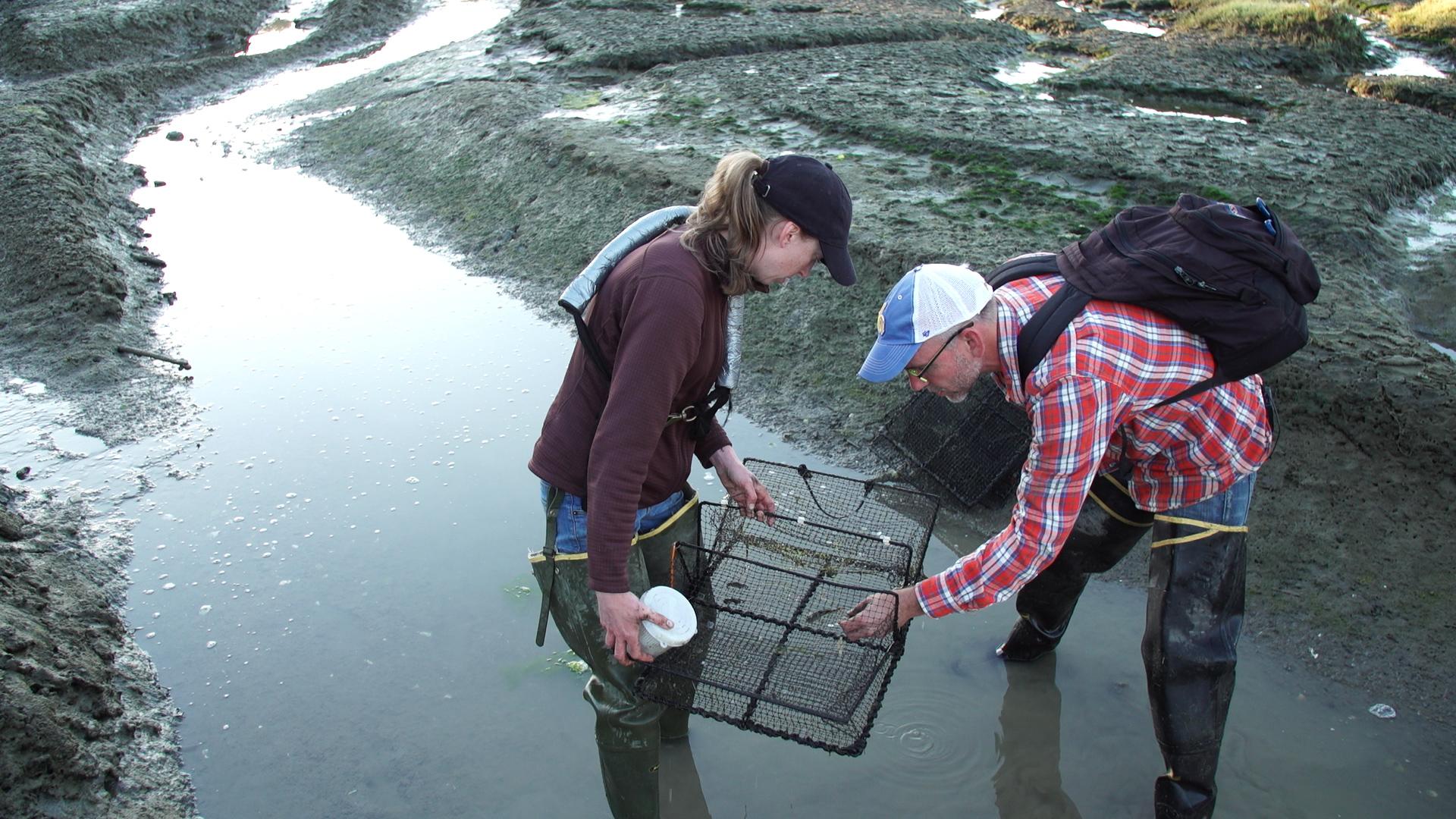
Emily Grason and Sean McDonald of the Washington Sea Grant Crab Team set traps on San Juan Island for invasive green crabs.
Greg Davis / KCTS 9
Emily Grason and Sean McDonald trudge through the mud of San Juan Island’s Westcott Bay on the hunt for something they hope not to find: A 3-inch menace: the European green crab.
In late August, a single adult male was found for the first time in Washington’s inland sea. University of Washington researchers responded, arriving at the location of that first sighting with hundreds of traps in tow.
"It might seem like it's crazy for us to have such an intense trapping effort for just a single crab being found. One crab, what's the big deal?" says Emily Grason, project coordinator for the Washington Sea Grant Crab Team. "But these crabs do tend to show up in numbers and where there's one, there's often more."
After three days, they found no additional green crabs. A good sign, but it turns out the battle against the destructive crabs is far from over. Just last week, a new report reached the UW research team: Another green crab was found 30 miles away on the shores of Padilla Bay by staff of the Padilla Bay National Estuarine Research Reserve. McDonald and Grason headed there next.
If there are more, it could be the beginning of something terrible.
Green crabs are considered one of the worst global invaders. From their home shores of Europe, green crabs have spread to South Africa, Brazil, Australia and both coasts of North America. They’ve made their way around the world by hitching a ride in seafood shipments and within ballast water of ships.
They were first found in San Francisco Bay in the late 1980s and have since slowly moved north. Their larvae get dispersed on ocean currents and can travel many miles along the coast before settling in intertidal zones and starting new colonies.
Green crabs are voracious predators. They feed on a wide range of marine life, including clams, oysters, mussels and juvenile crabs.
On the East Coast they’ve wrecked havoc: burrowing into marshes, riddling the banks with holes. Green crabs have been blamed for devastating Maine’s soft-shell clam industry and there’s concern that the invaders could threaten Puget Sound’s Dungeness crab, oyster, and clam fisheries and aquaculture operations.

Green crabs in Freeport, Maine destroyed local salt marshes and eelgrass beds.
Gabe Souza / Portland Press Herald
“If they reach the densities here that they do on the East Coast, it would be disastrous,” says McDonald, a University of Washington research scientist.
Once green crabs are abundant, they're nearly impossible to eradicate -- and most methods come with undesirable consequences. Spraying chemicals damages surrounding plants and animals. In Puget Sound, scientists had considered introducing a parasitic barnacle from Europe that infects green crabs. The parasite puts the crabs in a zombie-like state and destroys their capacity to reproduce. But there's a risk the parasite could infect other crabs species as well.
The crabs are edible, but not particularly tasty and some say they’re more work to eat than they’re worth in calories. And if green crabs took off as a commodity, that could lead to a situation where people would have less incentive to get rid of them. So eating our way out of this problem isn't a good solution, McDonald says.
“The only effective tool we have for eliminating green crab is trapping,” McDonald says. “But the only way for us to have any hope of reducing the population of green crab is if we find them early enough and that we attack them quickly.&rdqu

Westcott Bay, a salt marsh on San Juan Island in Washington's Puget Sound.
Jared Rusk / KCTS 9
The team has identified about 180 locations in Washington’s inland seas that could become prime habitat for green crabs. The researchers can’t monitor all of those locations on their own. They’re training local volunteers to become citizen scientists who can distinguish invasive green crabs from other native crab species.
Green crabs aren’t always green. Sometimes they’re bright red. The only sure way to identify green crabs, Grason says, is to count the sharp spines on either side of the crab’s eyes. A European green crab with have five spines on each side; native crabs won’t.
For more information, visit the Washington Sea Grant Crab Team's website.
